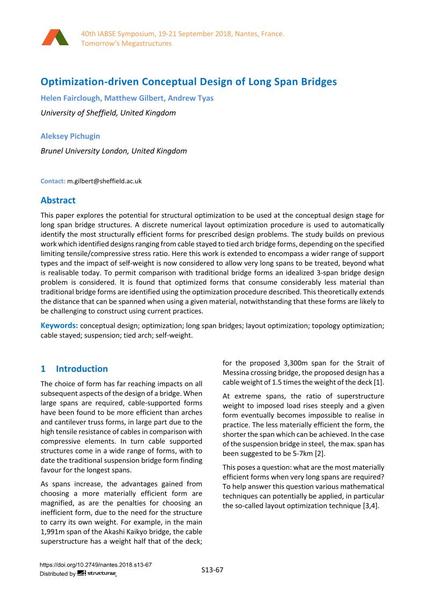Optimization-driven Conceptual Design of Long Span Bridges

|
|
|||||||||||
Bibliografische Angaben
| Autor(en): |
Helen Fairclough
(University of Sheffield, United Kingdom)
Matthew Gilbert (University of Sheffield, United Kingdom) Andrew Tyas (University of Sheffield, United Kingdom) Aleksey Pichugin (Brunel University London, United Kingdom) |
||||
|---|---|---|---|---|---|
| Medium: | Tagungsbeitrag | ||||
| Sprache(n): | Englisch | ||||
| Tagung: | IABSE Symposium: Tomorrow’s Megastructures, Nantes, France, 19-21 September 2018 | ||||
| Veröffentlicht in: | IABSE Symposium Nantes 2018 | ||||
|
|||||
| Seite(n): | S13-67 | ||||
| Anzahl der Seiten (im PDF): | 8 | ||||
| DOI: | 10.2749/nantes.2018.s13-67 | ||||
| Abstrakt: |
This paper explores the potential for structural optimization to be used at the conceptual design stage for long span bridge structures. A discrete numerical layout optimization procedure is used to automatically identify the most structurally efficient forms for prescribed design problems. The study builds on previous work which identified designs ranging from cable stayed to tied arch bridge forms, depending on the specified limiting tensile/compressive stress ratio. Here this work is extended to encompass a wider range of support types and the impact of self-weight is now considered to allow very long spans to be treated, beyond what is realisable today. To permit comparison with traditional bridge forms an idealized 3-span bridge design problem is considered. It is found that optimized forms that consume considerably less material than traditional bridge forms are identified using the optimization procedure described. This theoretically extends the distance that can be spanned when using a given material, notwithstanding that these forms are likely to be challenging to construct using current practices. |
||||
| Stichwörter: |
Suspension
|
||||
